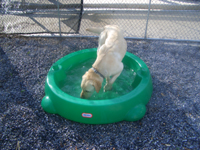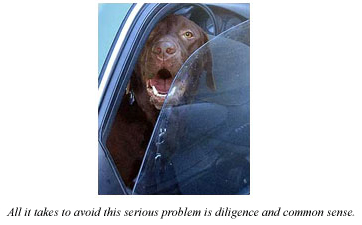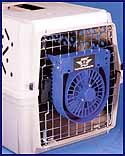


Christmas Store
The holidays are just around the corner so now is the time to fetch the finest gifts for the Labrador Lover on your Christmas list. We have over 100 gifts $50.00 and under. Visit our Christmas Store.
For the Lab
Bedding
Coats
Collars and Leads
Dog Bowls
Feeding Stations
Spa and Grooming
Toys and Treats
Travel and Accessories
For the Lab Lover
Apparel
Cards and Giftwrap
Fine Accessories
Gifts and All Occasions
Jewelry
Kids Only
For the Lab Home
Artwork
Books
Garden and Outdoor
Home Furnishings
Kitchen Accessories
Pillows, Throws, and Rugs
Gift ServicesGift Boxes
Gift Certificates
Heat Stroke
Heat stroke is a deadly condition that can kill your beloved companion, even with emergency treatment. The prime cause for all these terrible deaths is inattention by their owner. In most cases the family pet is left “for just a minute”…but unfortunately the owner is delayed and returns to find their pet collapsed, salivating, panting uncontrollably and perhaps unconscious. Even with heroic measures, many family pets die.
There are three primary ways pets get into trouble with overheating:
1. Being locked in a hot car.
2. Being left outside on a sunny day without access to shade.
3. Exercising excessively on hot, particularly humid days.
What is Heat Stroke?
Pets are at a disadvantage in being able to dissipate heat from their body in parked cars. The reason for this is that when a dog is confined to a space where the surrounding temperature and humidity are above tolerable levels, the dog’s body will begin to acquire heat from the environment faster than it can dissipate that heat. Expired air in a dog’s breath is 102 degrees and has 100 percent humidity, which in itself increases the level of humidity in the dog’s environment. Humidity interferes with the dog’s ability to rid itself of excess body heat. As the relative humidity approaches 100% the dog’s humid breath does not evaporate well…therefore less cooling…therefore the body suffers more from the heat.
Even when parked in the shade, a dog needs to inhale air cooler than their normal body temperature of 102 degrees. In fact, 80 degree air temperatures, especially in humid conditions, can be dangerous. A dog’s only means of dissipating excess body heat is through panting. Our four-legged friends only perspire around their paws, which is not enough to cool their body. To rid themselves of excess heat, animals pant. The air that moves through the nasal passages, picks up excess heat from the body. As it is expelled through the mouth, the extra heat leaves along with it. Unfortunately, in a parked car with the surrounding humidity of 100 percent, panting makes an inefficient means of cooling. Dogs can only pant so fast.
It only takes a few minutes for heat in a car to increase 40 degrees above the outside air temperature especially in direct sunlight. In general, the darker the car and the more windows it has, the faster it will heat up inside. Time, temperature and humidity are critical factors in the development of heat stroke in pets. An overheated dog first suffers from heat exhaustion; if he keeps getting hotter, it progresses to heat stroke. Once the animal’s cells reach 107 degrees, it is crucial for any chance of recovery to lower the dog’s core temperature as fast as possible. Otherwise, death will occur no matter what you try do to save the animal.
All living cells have limits to the temperature they can tolerate. When the temperature goes beyond those limits, cells break down and lose functional capacity, releasing chemicals within themselves that cause more adverse reactions. Eventually these cells cease to function and die. Tolerance to higher than optimum temperatures for dogs breaks down at around 107 degrees. The longer the cell is above the 107 degree level, the less chance there is for the cell to recover. The higher the temperature becomes above 107 degrees the faster the cell death (the state where the traumatized cell cannot recover from the heat injury).
Other Factors
While heatstroke occurs most often from leaving pets in unattended vehicles, there are other dangerous situations that account for the cause of deaths from heat stroke. Leaving pets outdoors without shade or shelter is just as dangerous as leaving them inside a hot car. Be sure they are not left tied out in the direct sunlight or kept outdoors in a run without sufficient shade or air circulation during warm sunny days.
Overweight dogs are also more prone to overheating due to the extra layers of fat that act as insulation and trap heat in their bodies restricting their breathing. Age is also a factor in an animal’s preponderance to overheat. Older dog’s organ systems may not be functioning at 100 percent, leaving them prone to overheating. Very young puppies may not have a fully developed temperature regulating system so they are more apt to overheat.
In addition, the shape of the dog’s nasal passage can contribute to their tendency to overheat. If you also have short faced (Brachycephalic) breeds such as Boxers, Pugs and Pekingese, they are more prone to heat stroke because their nasal passages are smaller and it’s more difficult for them to circulate sufficient air for cooling.

Yet another factor which comes into play is coat. A dark coat will become overheated more quickly than a lighter one. Long-haired and heavy double coated dogs also fare worse in the summer heat.

Signs of Heat Stroke
Symptoms of heat stroke are:
· Intense and rapid panting
· Wide eyed look of distress
· Salivation
· Staggering and weakness
· A body temperature of about 105 degrees or higher is probable evidence of heat stroke.
· Anxious expression
· Refusal to obey commands
· Rapid heartbeat
· Vomiting
· Gums that appear pale and dry
· Collapse and unconsciousness
Most heat stroke victims are dehydrated as well, and their blood thickens to the point that stagnation of blood, blood clotting, and eventual death of tissues.
Treatment for Heat Stroke
If your dog begins to exhibit signs of heat stroke, you must act quickly and calmly. Have someone call a veterinarian while you immediately try to cool them down. Often a pet will respond after a few minutes of cooling, only to succumb again to soaring temperatures so it is imperative to seek veterinary attention as soon as possible.
· Get your dog out of the direct sun and into shade or air conditioning.
· Rub cool damp towels in the dog’s groin area.

· Run the cool water over the tongue and mouth.
· Place your pet in a tub of cool running water.

· Hose down with water being sure the cool water contacts the skin of the under-belly and the inside of the dog’s legs.
· Apply rubbing alcohol to the dog’s pads.
· Offer Pedialyte to restore electrolytes.
· Don’t pour ice water on him or dunk him in an ice bath. This could be too big a shock to his system.
Check your dog’s temperature regularly during the process. Once the dog’s temperature has stabilized at around 102 degrees, you can stop the cool-down process. If you cannot get the dog cooled down, act quickly and take them immediatelyto a veterinarian. Heat stroke is a bona fide emergency!
At an animal hospital, the veterinary staff will work as quickly as possible to get the core body temperature down and blood pressure up. They generally will run blood work to see how the kidneys are functioning and provide intravenous fluids and anticoagulants as well. They may administer oxygen, cortisone and dextrose to help protect the traumatized cells.
Precautions
Thankfully, this situation is preventable if you keep in mind your dog’s inability to handle heat. While traveling there are crate fans and cool pads with your four legged friend. The best precaution is not to ever leave your pet in a vehicle on warm sunny days, even with the window cracked.
Many owners enjoy taking their Labs on weekend outings however flea markets, craft shows and other outdoor activities can be the worst place to bring a dog on a hot sunny day.

Excitement or discomfort brings on panting and elevated metabolic rate which elevates the dog’s temperature. Older pets have less resistance to stresses such as traveling, heat, noises, and unusual activities. Be mindful, too, that your dog’s pads can suffer heat trauma from contact with hot asphalt or other sun-scorched surfaces.
At home, always provide plenty of cool, fresh water. If your dog is outside on a hot day, make sure he has a shady spot to rest in. Doghouses are not good shelter during the summer as they can trap heat. You may want to fill a child’s wading pool with fresh water for your dog to cool off in.
Avoid strenuous exercise on extremely hot days. Take walks in the early mornings or evening, when the sun’s heat is less intense.
Summary
Heat + Humidity = Heat Stroke

Everyone knows that the inside of a car on a hot sunny day can be lethal. Leaving windows cracked is NOT sufficient to prevent heat stroke. Even during very mild weather, the interior of a vehicle can become quite hot and stuffy creating and unsafe environment for your dog. Inside temperatures can reach 120-130 degrees within minutes on a mild 70 degree day. During very warm or hot weather, the inside of a vehicle may reach 150 degrees and higher becoming deadly within several minutes. There are times when you need to consider if the wisest decision might be to leave your dog at home if you won’t be able to provide it frequent relief from the heat and humidity.
If you don’t believe our claims, try it for your self sometime. Park your vehicle in the sun, roll the windows down one to two inches, and sit there for as long as you can. Watch the time. Better yet, take an outdoor thermometer with you. Within minutes you will be quite uncomfortable, and we doubt you can stay for a full ten minutes. Remember, you can sweat and you will be sweating profusely, but your faithful companion can’t. If you have ever tried this experiment you will never leave your dog in a vehicle again!
 Can You Spot The Holiday Hazards?
Can You Spot The Holiday Hazards?It’s easy for pets, especially Labradors, to get into trouble during the holidays. You may get so busy that you lose track of what is going on with your dog.
Click here to learn more about: "Can You Spot The Holiday Hazards?"

Would you like to see your Lab pictured here? Send us images of your Lab and we may include them on our Home Page!
Labrador Links
The Verstaile Lab
History of the Lab
Advice
Travel
Featured Labs
Featured Artists
.jpg)


